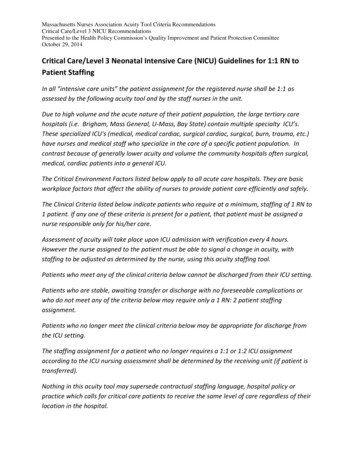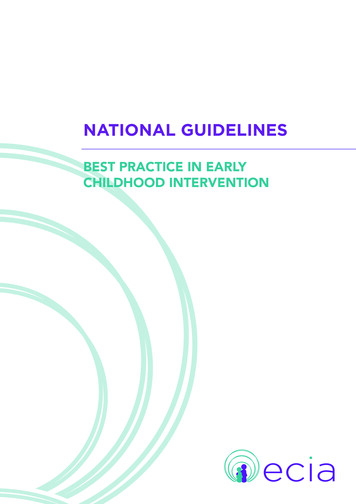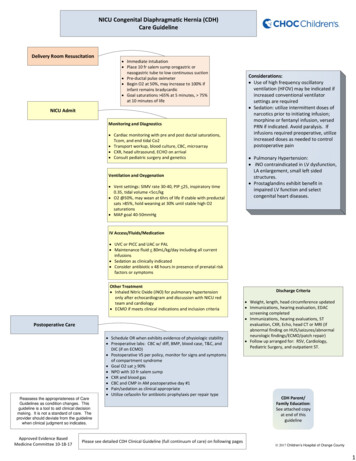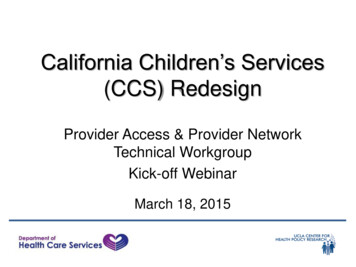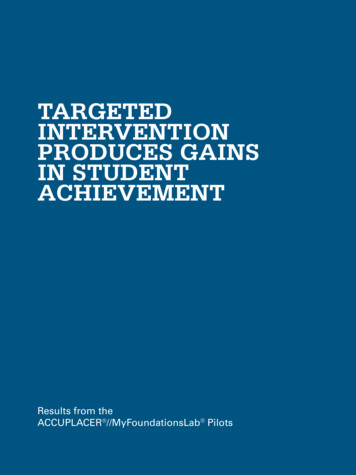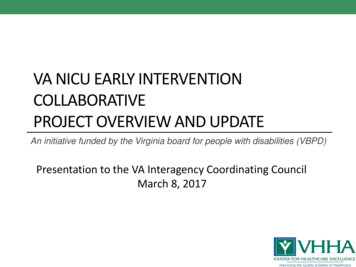
Transcription
VA NICU EARLY INTERVENTIONCOLLABORATIVEPROJECT OVERVIEW AND UPDATEAn initiative funded by the Virginia board for people with disabilities (VBPD)Presentation to the VA Interagency Coordinating CouncilMarch 8, 2017
NICU EI Collaborative Project LeadersCatherine Hancock MS, RN,PMHCNS, BCEarly Intervention AdministratorDept. of Behavioral Health andDevelopmental ServicesAbraham SegresVice PresidentQuality and PatientSafetyBetsy Cole Archer , MS,ASCPDirector,PerformanceImprovementWanda Clevenger BSN,RN, MBADirector, PerformanceImprovement
VHHA, VHREF, and The CenterVirginia Hospital & HealthcareAssociation Virginia Hospital Research &Education Foundation Non-profit foundation Alliance of 107 hospitals and30 health systems in Virginia The Center for HealthcareExcellence Improve healthcare byassisting members to achievetop-tier performance inquality, safety, & service75% of the funding for this project was provided by the Virginia Board for People with Disabilities under the federal DevelopmentalDisabilities and Bill of Rights Act. For more information on the Board, please contact: Virginia Board for People with Disabilities,1100 Bank Street, 7th Floor, Richmond, VA 23219, (800) 846-4464, or visit the Board’s website at www.vaboard.org
What are we trying to accomplish? The Virginia NICU Early Intervention Collaborative (the Collaborative)will achieve systems change of practice and improvement inoutcomes for all infants and young children by engaging all VirginiaNICUs and their community partners in a statewide learning andimprovement collaborative to enhance linkages to Early Intervention(EI) services for NICU patients and families. Improve/expand NICU referrals and follow up Enhance policies, practices & competencies Develop training models75% of the funding for this project was provided by the Virginia Board for People with Disabilities underthe federal Developmental Disabilities and Bill of Rights Act. For more information on the Board, pleasecontact: Virginia Board for People with Disabilities,1100 Bank Street, 7th Floor, Richmond, VA 23219, (800) 846-4464, or visit the Board’s website atwww.vaboard.org
Program Overview 18 month program – October 2016 – May2018 Involvement of: Individuals with developmental and otherdisabilities Patient & Family AdvisoryCouncil (PFAC); and Leaders in neonatal care, NICU, communityengagement, and EI. Guides the work of the collaborative Who are we helping? Infants and young children with disabilitiesin VA Virginia NICU staff, including nurses, socialworkers, etc. Community support/service agencies tocoordinate care for children and families75% of the funding for this project was provided by the Virginia Board for People withDisabilities under the federal Developmental Disabilities and Bill of Rights Act. For moreinformation on the Board, please contact: Virginia Board for People with Disabilities,1100 Bank Street, 7th Floor, Richmond, VA 23219, (800) 846-4464, or visit the Board’swebsite at www.vaboard.org
Activities & Status updateFacilitycommitment andonboarding22 hospital NICUs enrolledPromoting entGovernor McAuliffe’s PressRelease, June 2016Members of CollaborativeAdvisory Council on-boardand meeting held 2/14/2017Determine components ofdata request: operationaland performance outcomemeasuresCHCE Advisory Council,and VA InteragencyCoordinating Council(VICC) Meeting, September2016Patient and Family AdvisoryCouncils via partnershipwith NEW PATH and ARCof VA.Collect baseline dataHospital Coordinator’sattendance at Richmond,NoVa, Staunton, SouthBoston and TidewaterSystem Manager RegionalInfant & Toddler ConnectionMeetings.Analyze resultsShare results and developrecommendations forchange packet75% of the funding for this project was provided by the Virginia Board for People with Disabilities under the federalDevelopmental Disabilities and Bill of Rights Act. For more information on the Board, please contact: Virginia Board forPeople with Disabilities,1100 Bank Street, 7th Floor, Richmond, VA 23219, (800) 846-4464, or visit the Board’s website at www.vaboard.org
Virginia Hospital NICU CommitmentsBon Secours Regional MemorialInova Alexandria HospitalBon Secours St. Francis Medical CenterInova Children’s HospitalBon Secours St. Mary's HospitalInova Fair Oaks HospitalCarilion Clinic – Carilion Children’s HospitalInova Loudon HospitalCentra Virginia Baptist HospitalChildren's Hospital of The King's DaughtersMary Washington HospitalNovant Health UVA Health System Prince WilliamMedical CenterRiverside RegionalChildren’s National Medical Center, Washington DCSentara Princess Anne HospitalHCA Chippenham HospitalUniversity of Virginia Children’s Medical CenterHCA Henrico Doctors HospitalVirginia Hospital CenterHCA Johnston-Willis HospitalWinchester Medical CenterChildren’s Hospital of Richmond at VCU75% of the funding for this project was provided by the Virginia Board for People with Disabilities under the federalDevelopmental Disabilities and Bill of Rights Act. For more information on the Board, please contact: Virginia Boardfor People with Disabilities,1100 Bank Street, 7th Floor, Richmond, VA 23219, (800) 846-4464, or visit the Board’s website at www.vaboard.org
Hospital NICUs and EI REGIONS75% of the funding for this project was provided by the Virginia Board for People with Disabilities under the federal DevelopmentalDisabilities and Bill of Rights Act. For more information on the Board, please contact: Virginia Board for People with Disabilities,1100 Bank Street, 7th Floor, Richmond, VA 23219, (800) 846-4464, or visit the Board’s website at www.vaboard.org
9The Collaborative’s Advisory CouncilNameRoleErin Close Austin, LCSWChildren’s Services Manager, Developmental Services DivisionRichmond Behavioral Health AuthorityGail Briceland, RN, CPNP, MSNInfant & Toddler Connection of Central VAWanda Clevenger, BSN, RN, MBADirector, Performance Improvement, VHHAMaria DeLalla RN BSN BANurse Case Manager, Women & Children’s Services, Healthy Families NSVResource Specialist, Winchester Medical CenterTracey EdmanNew Path Family Support Coordinator, The ARC of VACatherine Hancock , MS, RN, PMHCNS, BCEI Administrator, Dept. of Behavioral Health and Developmental ServicesJamie LibanExecutive Director, The ARC of VAJen Barnes-Maddox, M EdNICU Family Support Program Coordinator at Henrico Doctors' HospitalMarch of DimesKathleen McCauley, AttorneyFamily representative and health care lawyerAlan Picarillo, MD, FAAPSheridan Children Services Medical Director, NICU, Henrico Doctors' HospitalLaura Speer, RNC-NIC, MSN, BSNNeonatal Intensive Care Unit, Clinical Director, Inova Children’s HospitalInova Fairfax Medical CampusSharlene StowersDirector of EI, Local System ManagerInfant and Toddler Connection of Shenandoah ValleyAd hoc members as needed75% of the funding for this project was provided by the Virginia Board for People with Disabilities under the federal DevelopmentalDisabilities and Bill of Rights Act. For more information on the Board, please contact: Virginia Board for People with Disabilities,1100 Bank Street, 7th Floor, Richmond, VA 23219, (800) 846-4464, or visit the Board’s website at www.vaboard.org
Engaging the Voice of the Patient andFamilyIdentifying how best to learn from the patient and family experience Partnership with Arc of VA New Path Statewide work with 24 local chapters. Input from new and graduate families onboth NICU and community basedexperiences. Link in to existing communication toolsto engage, support and inform includingnewsletter and blog.75% of the funding for this project was provided by the Virginia Board for People with Disabilities under the federal DevelopmentalDisabilities and Bill of Rights Act. For more information on the Board, please contact: Virginia Board for People with Disabilities,1100 Bank Street, 7th Floor, Richmond, VA 23219, (800) 846-4464, or visit the Board’s website at www.vaboard.org
How will we achieve our aim? Improve/expand NICU referralsand follow up Enhance policies, practices &competencies Develop training models75% of the funding for this project was provided by the Virginia Board for People with Disabilities under the federal DevelopmentalDisabilities and Bill of Rights Act. For more information on the Board, please contact: Virginia Board for People with Disabilities,1100 Bank Street, 7th Floor, Richmond, VA 23219, (800) 846-4464, or visit the Board’s website at www.vaboard.org
How do we know there’s a need aPerform gapanalysisDevelopchangepackage75% of the funding for this project was provided by the Virginia Board for People with Disabilities under the federal Developmental Disabilitiesand Bill of Rights Act. For more information on the Board, please contact: Virginia Board for People with Disabilities,1100 Bank Street, 7th Floor, Richmond, VA 23219, (800) 846-4464, or visit the Board’s website at www.vaboard.org
13What We Know From the Literature 65-70% of Children who enter EI with developmental delays are closer to age-expectedskills when they exit EI1 Integrating community-based EI with medical pediatric care is recommended as a bestpractice by the American Academy of Pediatrics. 2 Multiple studies identify that eligible infants may be missed and not referred to EI 3,4 and 5 A study comparing EI referral rates to those of infants on oxygen to pulmonology and infants withvision impairment to ophthamology concluded that referrals of developmentally delayed infantsto EI were due to quality improvement or system issues. 6 Reasons for gaps in EI referrals include: simple oversights or communication failures betweenhospitals, EI and families. Lack of formal tracking of referral outcomes precludes identification of best practice andstandardization.1TheEarly childhood Technical Assistance Center Website. Part C SPP/APR 2011 Indicator Analysis-FFY 2010. 2012March 22, 2013 Available at: http://ectacenter.org/ pdfs/partc/partc sppapr 12.pdf.2 Adams, R., Tapia, C., and The Council on Children with Disabilities. Early Intervention, IDEA Part C Services, and the Medical Home: Collaboration for Best Practice and Best 13-2305. downloaded on 2/06/2017.3Wang, C., et al., Factors Influencing the Enrollment of Eligible Extremely-Low-Birth-Weight Children in the Part C Early Intervention Program. Acad Pediatr. 2009; 9(4): 283-287.doi:10.1016/j.acap.2009.04.001.4Little, A. et al., Understanding Barriers to Early Intervention Services for Preterm Infants: Lessons from Two States. Acad Pediatr. 2015; 15(4): 430-438. doi:10.1016/j.acap.2014.12.0006.5Tang, B., et al., Missed Opportunities in the Referral of High-Risk Infants to Early Intervention. Pediatrics . Vol. 129, No. 6, June 2012. doi: 10.1542/peds.2011-2720.6 Ibid.75% of the funding for this project was provided by the Virginia Board for People with Disabilities under the federal Developmental Disabilitiesand Bill of Rights Act. For more information on the Board, please contact: Virginia Board for People with Disabilities,1100 Bank Street, 7th Floor, Richmond, VA 23219, (800) 846-4464, or visit the Board’s website at www.vaboard.org
What are the Indicators for EI Referral?A child and family may receive EI supports and services if the child is up to threeyears old AND: At least 25% below chronological oradjusted age, in one or more areasof development, OR Manifests atypical development orbehavior, which is demonstrated byone or more specified criteria (evenin the absence of a 25%developmental delay). For children born prematurely(gestation 37 weeks), the child’sadjusted age is used to determinedevelopmental status. Chronologicalage is used once the child is 18months old. Has a diagnosed condition that willvery likely cause a developmentaldelay. This includes: Genetic disorders, such as Downsyndrome, Cleft lip and/or palate NICU stay of greater than or equal to 28days Autism Spectrum Disorder Vision and/or hearing lossData Sources: States’ and territories’ definitions of/criteria for IDEAPart C eligibility (updated March 4, 2015)Infant & Toddler Connection of Virginia,http://www.infantva.org/Families.htm website accessed 2/7/201775% of the funding for this project was provided by the Virginia Board for People with Disabilities under the federal Developmental Disabilitiesand Bill of Rights Act. For more information on the Board, please contact: Virginia Board for People with Disabilities,1100 Bank Street, 7th Floor, Richmond, VA 23219, (800) 846-4464, or visit the Board’s website at www.vaboard.org
Birthrate Stable but EI Need IncreasingChildren Served Each Year by EI(Includes new referrals and continuing cases)Data Sources: Report on Virginia’s Part C Early Intervention SystemFY2016 (July 1,2015 – June 30, 2016)Virginia Department of Health, Data Portal, Demographics websiteaccessed 2/7/2017. ta Sources: Zehner, Anne “Neonatal Abstinence Syndrome in Virginia: A Report on Current findings and Trendsfrom Hospital Discharge Data, 1999-2013” Office of Family Health Services, VDHVirginia Department of Health, Data Portal, Maternal & Child Health website accessed health/
EI Referrals All Sources 2016Referral Outcome(16,019 infants)Receiving Services 60%Unable to Contact 14%Declined Evaluation 14%Determined Ineligible 10%Note 2% received services from another provider.(Data Source: Report on Virginia’s Part C EarlyIntervention System FY2016 (July 1,2015 – June30, 2016))75% of the funding for this project was provided by the Virginia Board for People with Disabilities under the federal Developmental Disabilitiesand Bill of Rights Act. For more information on the Board, please contact: Virginia Board for People with Disabilities,1100 Bank Street, 7th Floor, Richmond, VA 23219, (800) 846-4464, or visit the Board’s website at www.vaboard.org
NICU Referrals to EI? Are NICUs referring allinfants that are eligibleand/or have a condition ordiagnosis that makes themhighly probable of beingeligible are referred to EI?75% of the funding for this project was provided by the Virginia Board for People with Disabilities under the federal Developmental Disabilitiesand Bill of Rights Act. For more information on the Board, please contact: Virginia Board for People with Disabilities,1100 Bank Street, 7th Floor, Richmond, VA 23219, (800) 846-4464, or visit the Board’s website at www.vaboard.org
Baseline Data – agree to true data sourceLarge datadiscrepancybetween sources Challengesmay be due toinfants transferred Virginia Dept. of Healthto NICU after birth. Only captures NICU admissions through data entered on birth certificate Most recent data available is 2013 (5,029 NICU Admissions) Virginia Health Information (VHI) Does not specify NICU as a bed type for 2013, 2014 and 2015discharges from these beds 9,244; 9,143; and 17,810, respectfully Infant intermediateAre all providerscategorizing buckets Infant specialtybased on same criteria? Infant sub-specialty Infant and Toddler Online Tracking System (ITOTS) Limited data set that is not linked to other State systems75% of the funding for this project was provided by the Virginia Board for People with Disabilities under the federal DevelopmentalDisabilities and Bill of Rights Act. For more information on the Board, please contact: Virginia Board for People with Disabilities,1100 Bank Street, 7th Floor, Richmond, VA 23219, (800) 846-4464, or visit the Board’s website at www.vaboard.org
Agreed to Baseline Use the Infant & Toddler Connection of VA PracticeManual (Chapter 5 Eligibility Criteria) list ofdiagnoses and conditions that either: automatically qualify an infant for EI services or indicates that it is highly probable the infant will havedevelopmental delays related to the diagnosis and wouldbenefit from EI services Take the English descriptions of diagnosis andconditions and assign ICD10 codes.75% of the funding for this project was provided by the Virginia Board for People with Disabilities under the federal DevelopmentalDisabilities and Bill of Rights Act. For more information on the Board, please contact: Virginia Board for People with Disabilities,1100 Bank Street, 7th Floor, Richmond, VA 23219, (800) 846-4464, or visit the Board’s website at www.vaboard.org
Other Baseline and Performance DataVA NICU EI Data DescriptionNumeratorDenominator1) Number of families receiving information on EIand availability of EI services post NICU discharge# families who received EI informationwhile on the NICUNICU and other hospital bed dischargesin specified ICD10 Codes# infants discharged from NICUNICU and other hospital bed dischargesin specified ICD10 CodesAll infants DC from Hospital# NICU referrals to EINICU discharges2) Number of infants DC from hospital withdiagnosed condition (using ICD 10 Codes) thatmeets EI eligibility criteria Separate data by NICUand other hospital bed3) Number of infants DC from hospital withdiagnosed condition (using ICD 10 Codes)considered a risk factor for developmental delaysand thus, supporting EI referral. Separate data byNICU and other hospital bed.4) Number NICU referrals to EI5) Number of NICU grads eligible for services and # EI eligible NICU grads referred to EIwhose family declined services, include why whose family declined assessmentservices were declined.All infants DC from Hospital# EI eligible NICU grads referred toEIA special thank you to Mary Anne White, EI System Manager for her work on theICD10 Coding of the Practice Manual!75% of the funding for this project was provided by the Virginia Board for People with Disabilities under the federal DevelopmentalDisabilities and Bill of Rights Act. For more information on the Board, please contact: Virginia Board for People with Disabilities,1100 Bank Street, 7th Floor, Richmond, VA 23219, (800) 846-4464, or visit the Board’s website at www.vaboard.org
Other Baseline and Performance Datacont.VA NICU EI Data DescriptionNumeratorDenominator6) Number of NICU grads eligible for services and # EI eligible NICU grads referred towhose family declined services, include why EI whose family declinedservices were declined.assessment# EI eligible NICU grads referred to EI7) EI Referral source distribution by regionAll EI referralsEI Hospital referral8) Number of NICU discharges going to foster care othat are referred to EI, number that agree to EI,number that decline EI.oo# NICU DC’s to foster careAND referred to EI# NICU DC’s to foster care# NICU grads in foster care and referred to EI# NICU grads in foster carethat agree to EI# NICU grads in foster carethat decline EI9) Number of infants and/or young children withdisabilities who have the services/supports neededto reach developmental goals.to be determinedEI – IFSP10) Number of infants receiving benefit from EIservicesto be determinedEI – IFSP75% of the funding for this project was provided by the Virginia Board for People with Disabilities under the federal DevelopmentalDisabilities and Bill of Rights Act. For more information on the Board, please contact: Virginia Board for People with Disabilities,1100 Bank Street, 7th Floor, Richmond, VA 23219, (800) 846-4464, or visit the Board’s website at www.vaboard.org
Quantitative and Qualitative Information Understanding the challenges to engagement How to best engage a parent who may be overwhelmed byhis/her infant’s medical condition How to best engage a teen parent How best to engage an addicted parent and infant withNeonatal Abstinence Syndrome (NAS) How best to engage a parent in denial How best to engage a parent without a stable home How best to clarify roles and support from NICU specialtyclinics, pediatrician, EI, Department of Education How best to support completion of forms that will provideassess to services75% of the funding for this project was provided by the Virginia Board for People with Disabilities under the federal DevelopmentalDisabilities and Bill of Rights Act. For more information on the Board, please contact: Virginia Board for People with Disabilities,1100 Bank Street, 7th Floor, Richmond, VA 23219, (800) 846-4464, or visit the Board’s website at www.vaboard.org
Surveys & Site Visits/Meetings to LearnBest Practices and Service GapsParent/FamilyEI System ManagersNICU Leaders75% of the funding for this project was provided by the Virginia Board for People with Disabilities under the federal DevelopmentalDisabilities and Bill of Rights Act. For more information on the Board, please contact: Virginia Board for People with Disabilities,1100 Bank Street, 7th Floor, Richmond, VA 23219, (800) 846-4464, or visit the Board’s website at www.vaboard.org
Early InsightsNo Single Point/Process for EI Referral/AccessVariations The process for introducing EI services to family members The timing of when an EI referral is made The information provided as part of EI referral Education materials provided to parents Mis-information exists related to EI services (i.e., if you are in aNICU Follow Along Clinic you cannot access EI services)75% of the funding for this project was provided by the Virginia Board for People with Disabilities under the federalDevelopmental Disabilities and Bill of Rights Act. For more information on the Board, please contact: Virginia Board forPeople with Disabilities,1100 Bank Street, 7th Floor, Richmond, VA 23219, (800) 846-4464, or visit the Board’s website at www.vaboard.org
The power of stories 75% of the funding for this project was provided by the Virginia Board for People with Disabilities under the federalDevelopmental Disabilities and Bill of Rights Act. For more information on the Board, please contact: Virginia Board forPeople with Disabilities,1100 Bank Street, 7th Floor, Richmond, VA 23219, (800) 846-4464, or visit the Board’s website at www.vaboard.org
What changes can we make that will result in an improvement? Review and optimizepolicies/procedures Design and conduct trainingprograms Facilitate dialogue betweenNICU services, EI RegionalSystem Managers and NewPath75% of the funding for this project was provided by the Virginia Board for People with Disabilities under thefederal Developmental Disabilities and Bill of Rights Act. For more information on the Board, please contact:Virginia Board for People with Disabilities,1100 Bank Street, 7th Floor, Richmond, VA 23219, (800) 846-4464, or visit the Board’s website atwww.vaboard.org
Activities planned: Qtrs. 1 & 2, 2017Foundation for rmGapAnalysisBegin Workfor ChangePackage75% of the funding for this project was provided by the Virginia Board for People with Disabilities under the federalDevelopmental Disabilities and Bill of Rights Act. For more information on the Board, please contact: Virginia Board forPeople with Disabilities,1100 Bank Street, 7th Floor, Richmond, VA 23219, (800) 846-4464, or visit the Board’s website at www.vaboard.org
28Questions/Comments/SuggestionsWanda Clevenger, wclevenger@vhha.com or (804) 965-1202
Program Overview 18 month program - October 2016 - May 2018 Involvement of: Individuals with developmental and other disabilities Patient & Family Advisory Council (PFAC); and Leaders in neonatal care, NICU, community engagement, and EI. Guides the work of the collaborative Who are we helping? Infants and young children with disabilities
